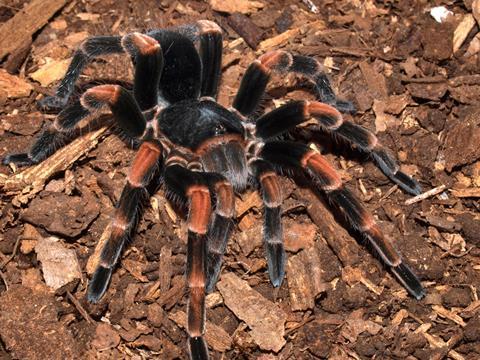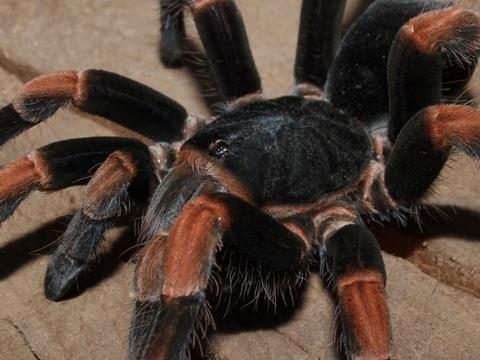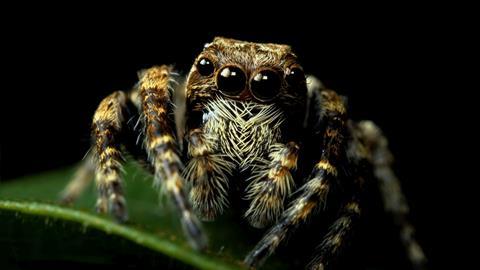The study of microbiota associated with the venoms of higher organisms (i.e. venom-microbiomics) is an emerging field that offers relevant information for researchers interested in microbial ecology, evolution, and natural products. Additionally, it provides essential information for the adequate medical treatment of bites and stings from venomous animals. In this context, a recent study published in Journal of Applied Microbiology explores the toxins and presence of pathogenic bacteria in the venoms and excreta of eight species of Neotropical spiders from the Theraphosidae family.
Tarantulas (family Theraphosidae) comprise a group of hairy and often large arachnids, currently consisting of 168 genera. Tarantulas are among the largest predatory arthropods in tropical regions. Although tarantula bites are not usually lethal to humans and only some of their attacks require medical treatment, their venomous bites can kill small animals. In Neotropical countries, there is a belief that many injuries in farm animals are caused by tarantulas, which is why they are also known as “pica caballo” (which translates to “horse biter”). These extraordinary animals, which often cause panic due to their appearance and aggressive behavior, have several strategies to defend themselves from their enemies. These strategies include releasing stinging hairs, utilizing vertical movements of their pedipalps to adopt upright postures, and using their chelicerae to inject venom. Costa Rica, being one of the most biodiverse countries in the world, hosts a great diversity of venomous animals, including nearly 40 species of tarantula.

These spiders primarily inhabit burrows that they themselves construct in the forest floor. However, there are at least two genera present in Costa Rica that live in trees. They are opportunistic hunters that take advantage of a variety of prey, mainly insects, although less common prey such as small reptiles, mammals, and birds have also been recorded. Generally, they have two reproductive periods: the first is usually associated with the onset of the rainy season in May, and the second at the end of the year in October. During these periods, the males wander through the forest or cities in search of females to mate with and perpetuate their species. For this reason, many people often find spiders inside their homes, which provokes fear and often leads to these visits being recorded on citizen science sites to seek help with identifying the individual.
Tarantulas are distributed throughout Costa Rica, from sea level to Cerro Chirripó, which reaches 3,820 meters above sea level. Their size ranges from very small species, approximately 3 cm in length, to the largest species, which exceeds 20 cm in length. Among the smaller groups is the genus Acanthopelma, while the largest species belong to the genus Sericopelma.
Despite their reputation and the many myths surrounding them, this type of spider rarely causes accidents due to bites. In fact, they are often highly prized as pets. Since Costa Rica is a very diverse country, with endemic species belonging to this group of spiders, illegal smuggling to introduce them into the pet market is common. This illegal extraction of individuals from their natural habitat endangers the species, making conservation measures necessary to ensure their survival.

Venoms produced by animals are complex mixtures of chemical substances capable of causing injuries, functional alterations, or even death in a living being. In the case of tarantulas, the venoms are usually not lethal to humans and are composed of mixtures of toxins, including terafotoxins, barytoxins, hexatoxins, latroinsectotoxins, zadotoxins, gomesin, and acanthoscurins, among others. A recent study on the venom composition of tarantulas from Costa Rica demonstrated that the toxins in these spiders are highly diverse, with significant variations even between species of the same genus.
Beyond the chemical composition of venoms, there has recently been increased interest in understanding the accompanying microbiota and its role in envenomation. Researchers worldwide have emphasized the importance of studying envenomation comprehensively, considering both abiotic and biotic components. This perspective led to the emergence of the field of venom-microbiomics, which aims, among other things, to examine the risk of primary infections during bites or stings from venomous animals and to understand the adaptation mechanisms of microorganisms to an environment that is chemically hostile and traditionally considered sterile. Venom-microbiomics is also significant for the field of natural products, as it has been reported that venoms, in addition to toxins, can contain up to 3,000 different molecules, representing a vast chemical space for obtaining bioactive compounds. The variety of non-protein molecules and their biological activity is another area that remains poorly explored in venoms, presenting a significant opportunity for scientists from different regions of the world.
The information provided by venom-microbiomics studies will enable more accurate medical treatments for stings or bites from poisonous animals, potentially including the use of antibiotics. It is important to mention that it is still unclear whether the microbiota associated with venoms originates from the venom production glands or results from contamination of the inoculating organs (i.e., fangs, venom duct, mouth, etc.). In either case, these microorganisms are part of the material inoculated during a bite or sting, making their study clinically significant.

The study conducted on eight species of tarantulas from Costa Rica demonstrated that potentially pathogenic bacteria belonging to the genera Stenotrophomonas, Serratia, Bacillus, Acinetobacter, Microbacterium, and Morganella, among others, are present in their venoms. Additionally, it was demonstrated that many of these bacteria were capable of producing hemolysins, which are considered an important virulence factor involved in cell lysis. This suggests a risk of primary infection following a tarantula bite. The study also examined the gut microbiota of these tarantulas, as previous observations have shown that several species of these spiders deposit their excrement on the victim when they bite. The analysis of the gut microbiota of the eight species of tarantulas also revealed the presence of potentially pathogenic bacteria (e.g. Pseudomonas, Bacillus, Comamonas, Morganella, Stenotrophomonas, and Staphylococcus) with hemolytic activity, which could participate in primary infection in an open wound. The results of the study showed that Pseudomonas was particularly abundant in the excreta. This is an extremely diverse taxon, found in a wide variety of ecosystems, including soils, waters, animals, humans, and environments contaminated with metals and hydrocarbons, among others. Due to its high adaptive capacity, it is not surprising to find this taxon in the gut microbiota of tarantulas. However, its functions and its relationship with the host are still not understood.
Stenotrophomonas, a pathogenic bacterium frequently found in venoms
The study carried out on tarantulas from Costa Rica demonstrated the recurrent presence of bacteria from the genus Stenotrophomonas in both their venoms and excreta. Members of this genus have been reported in venomous animals worldwide, including other spider species, in cone snail venom ducts, and in the oral cavities of snakes and Komodo dragons. This undoubtedly raises very interesting questions for future research on the functions and adaptive mechanisms of Stenotrophomonas in these ecosystems. Could these Stenotrophomonas species have specialized characteristics to survive in this environment? Members of this genus were initially classified within the genus Pseudomonas and have shown high versatility in adapting to different ecosystems, including soils, foods, animals, plants, and humans. Specifically, Stenotrophomonas maltophilia has been reported as a pathogen for humans, primarily causing respiratory tract infections. However, its involvement in skin and soft tissue infections, bacteremia, urinary tract infections, eye infections, and many other conditions has also been documented.

Stenotrophomonas is considered a nosocomial pathogen with increasing drug resistance and high mortality rates, which will require much more attention from the scientific community in the coming years. The high genetic and phenotypic diversity shown by members of this genus underscores the need for in-depth study. In the context of their presence in the venoms of animals such as spiders or snakes, it is important not only to understand their adaptation mechanisms but also their virulent capacities, which can cause infections in humans following bites or stings.
The field of venom-microbiomics is strengthening not only as an opportunity for better medical treatment of venomous animal bites or stings, but also as a means to explore a new ecosystem, learn about evolution, and study a microbiota with potential biotechnological applications. Currently, the Costa Rican research group is conducting studies similar to the one carried out on tarantulas, focusing on animals of greater relevance to public health, specifically snakes. In Costa Rica, it is known that about 77% of snake bites develop an infectious process, so the analysis of the microbiota associated with their venoms is highly relevant.













No comments yet